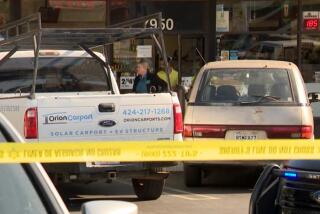‘Road Rage’ Takes a Turn for the Worse
- Share via
Armed with everything from firearms to Perrier bottles, pepper spray and the occasional egg, America’s drivers are taking their frustrations out on each other in startling numbers.
It was road rage that led two drivers to chase one another in rush-hour traffic on the George Washington Memorial Parkway in McLean, Va., reaching speeds of 80 mph before crashing into oncoming traffic. The four-car crash left three people dead.
Another example: Near Cicero, N.Y., the drivers of a car and a Mack truck tried to cut each other off for about 25 miles on Interstate 81--until one pointed a .45-caliber semiautomatic handgun at the other.
“What’s common is the feeling of hostility,” says Leon James, professor of psychology at the University of Hawaii. “As soon as that’s generated among millions of drivers, you have the potential for open warfare.”
There was a 51% jump in road violence from 1990 to 1995, according to a study by the American Automobile Assn. for Traffic Safety. It reported that 10,037 violent clashes led to 218 deaths and 12,610 injuries.
“What used to be just two people screaming at each other is now one person losing it and pulling the trigger,” said security expert Lou Mizell, who conducted the AAA study.
The results are only “the tip of the iceberg,” the AAA said. Few states even track instances of roadway hostility. Although there is no one typical aggressive driver, patterns do emerge from the study.
The majority are males age 18 to 26. Most are “relatively young, poorly educated with criminal records, histories of violence, and drug or alcohol problems, and many have recently suffered an emotional or professional setback,” the report said.
Only about 4% of aggressive driving incidents involve women. And when most women attack, they use their vehicle as a weapon about 70% of the time, the study determined.
“It’s one thing to have negative thoughts, but when it turns into action, then they need help,” said Arnold Nerenberg, a Southern California-based psychologist who has developed “The 10-Step Compassion Program” for overcoming road rage.
Lessons include tips on consideration, smiling, forgiveness and “Survival. . . . If you show your rage by yelling or making obscene gestures, someone may get seriously hurt. Take a deep breath and just say, ‘I’m angry, but not for long. It’s just not worth it.’ ”
Nerenberg encourages clients to call him by cellular phone when they feel a burst of rage coming on. For the seriously perturbed, he’ll even perform ride-along therapy.
Nerenberg and Hawaii professor James agree that people need to practice more patience--sort of a Zen method of driving.
“A lot of it’s just integrating yourself into a cooperative rather than a competitive situation,” James said.
More to Read
Sign up for Essential California
The most important California stories and recommendations in your inbox every morning.
You may occasionally receive promotional content from the Los Angeles Times.













